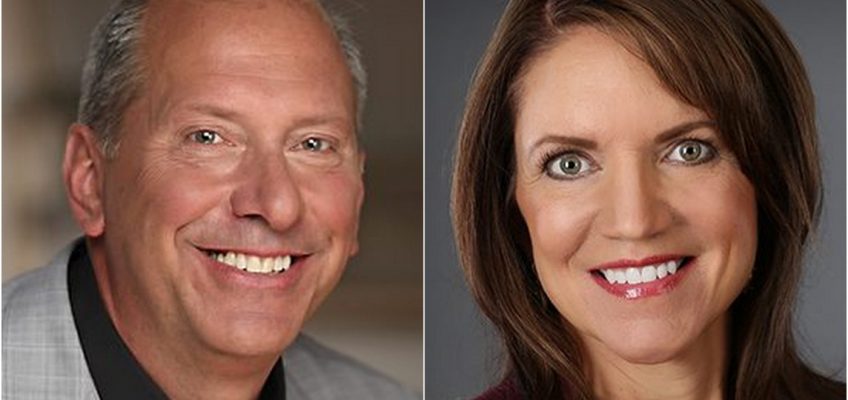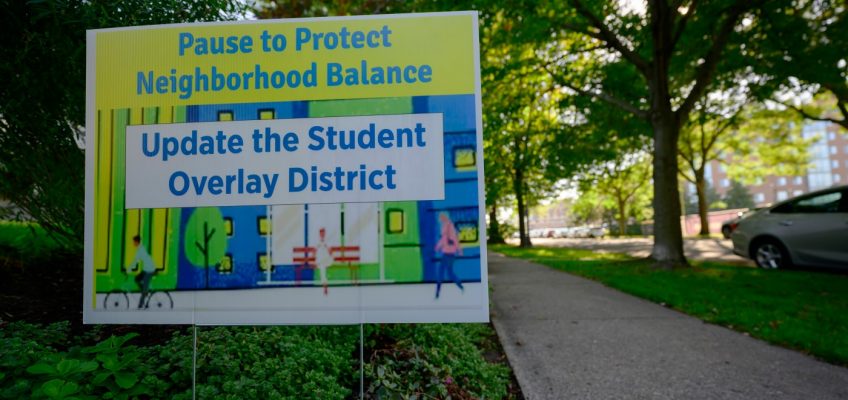The single-family home at 2133 Selby Ave. was there one day, gone the next. A few days after its Sept. 19 demolition, Tim Flanigan was surprised to see its garage torn down, and then excavators digging deep into the foundation and front yard.
When Flanigan checked property records through PAULIE, the city’s new online web portal for inspections and permitting, there was no evidence the city had issued a demolition permit.
He went downtown to talk to officials in the city’s Department of Safety and Inspections in person, and was told no such permit yet existed. The property is registered to a limited liability company, MJ Properties MN, LLC of Bloomington. Efforts to reach MJ Properties for comment were not successful.
“They told me there the application had been submitted and wasn’t even yet reviewed,” said Flanigan on Tuesday. The city later issued a stop-work order, but by then, the demolition had already taken place.
Tim Flanagan stands in front of a hole in the ground which will become a six unit college housing apartment along Selby Ave in St. Paul on Friday, Sept. 26, 2025. (John Autey / Pioneer Press)
Single-family zoning eliminated
If developers and property owners seem to be getting ahead of themselves in the neighborhood, there may be good reason.
In 2012, homeowners living near the University of St. Thomas convinced the city of St. Paul to slow the construction of privately-owned student rental housing in the area by creating an overlay district separating new registered student dwellings from existing ones by at least 150 feet.
Over the past year or so, developers reading through the fine print have found a work-around. That’s in turn led to the construction, permitting or conversion of some 24 new privately-owned student rental buildings in the blocks around the intersection of Cleveland and Ashland avenues, just off campus.
The St. Paul City Council voted to eliminate single-family zoning citywide in October 2023, opening the door to multi-unit residences within almost every zoning district in the city. The 150-foot buffer written into the overlay district applies to single-family homes and duplexes, but the language is silent on creating a separation requirement between other types of dwellings.
The result has effectively upended the student rental housing overlay district near St. Thomas, which has since been inundated by building permit applications.
Two large college rental apartments occupy lots that once belonged to much smaller single family homes on Ashland Ave. in St. Paul on Friday, Sept. 26, 2025. (John Autey / Pioneer Press)
Student housing
Flanigan can point to two single-family homes slated to be torn down and replaced with side-by-side six-plexes at 2149 and 2143 Selby Ave., which could span 24 bedrooms between them. The properties are both registered to private investors based outside the city — the Elliot Capital Group of Eden Prairie.
“If you have entire blocks that are only student housing, it creates a tipping point and makes the neighborhood structurally different,” Flanigan said. In a single block of Cleveland, “where there were maybe 20 students, now there’s going to be maybe 80 students.”
“Essentially, what we’ve asked for is a moratorium just for this type of construction — duplex to six-plex — so as a community we can ask, ‘Why is it only happening in this part of the city?’” Flanigan added. “Should it be done in this way or is it going to create problems in the neighborhood?”
Rather than impose a moratorium on the new student housing developments, city officials have largely treated the new units as a welcome trend at a time of sluggish housing growth in a city that could use more property tax base.
A “moratorium isn’t before the council,” said Ward 4 Council Member Molly Coleman on Wednesday, noting she would continue to work with DSI on quality-of-life concerns within the overlay district.
‘A bit of a land rush’
Flanigan, who chairs the grassroots group Neighbors for Responsible and Livable Development, said he and his fellow members have tracked two dozen new student rental properties in recent months as they’ve been built, converted or permitted. The units, he said, are marketed exclusively to students at monthly rents of about $1,000 per bedroom, using a website where St. Thomas invites property owners to list housing for rent near campus.
“Most of what has gone up so far is very large duplexes and triplexes that house 12 or 15 students at a minimum. There’s that many bedrooms,” Flanigan said. “And there’s no minimum setbacks, minimum side setbacks and no requirement for green space or tree replantings. There’s no back yard so all the partying happens in the front yard.”
“It’s a bit of a land rush. None of the units have any affordability requirements,” he added. “The applications to do these were duplexes or triplexes, but they’re actually rented by the room — like rooming houses — so there’s six individual leases for six bedrooms, which is actually not a permitted structure under H1 and H2 zoning.”
Danielle Hokason grew up in the neighborhood and lives in a duplex she’s owned for 20 years near Wilder and Portland avenues, about a block off campus. She’s seen about seven homes come up on Ashland, the street she grew up on.
“Everything is concrete now,” said Hokason, who can point to blocks where century-old trees no longer stand. “They’ve paved over parking lots and cut down trees. All the noise is amplified when you get rid of all of the green space.”
“You lose some of the buffer,” she added. “Saturday was pretty loud.”
Essentia exits talks with UMN, Fairview on ‘All-Minnesota’ health solution
St. Paul Regional Water Services opens $250M new McCarrons treatment plant
St. Paul: I-94, I-35E closures this weekend, also John Ireland Blvd. bridge work in October
St. Paul: Osborn Plaza is getting a renovation, possibly a new name
New map highlights Washington County home deeds with racial covenants
Call for moratorium on new student rentals
In response, Neighbors for Responsible and Livable Development have called for a temporary moratorium on the construction of new student rental housing within the overlay district until new rules can be sorted out. Their proposal has won the support of the Union Park District Council and the West Summit Neighborhood Advisory Council.
The Macalester-Groveland Community Council’s land-use committee supported the moratorium, but after lengthy discussion, the full Mac-Groveland district council did not.
“The voices that were coming through were the voices for the need for housing, not a moratorium,” said Laura Wallace, executive director of the Mac-Groveland Community Council.
University of St. Thomas responds
Jerome Benner, a spokesperson for St. Thomas, said the university has not taken an official stance on the moratorium proposal. However, it has held space to facilitate community discussions, which Flanigan called helpful.
Benner said the university wants more on-campus housing, but city regulations dictating building heights, campus boundaries and other details have been tough to navigate.
“Our overall student population has held steady in recent years, and our residence halls are currently at capacity,” said Benner, in a written statement. “We are seeing growing demand from students who want to live on campus, and we believe expanding on-campus housing would benefit both students and the neighborhood, as well as contribute to the city’s broader effort to increase housing availability. Right now, that option is significantly limited by the current Conditional Use Permit, which has been in place since 2004.”
No council support for moratorium
The neighbors group has held at least three community meetings in the past nine months, drawing 75 to 150 residents at a time, and hosted the candidates for the Ward 4 seat on the city council for a discussion this summer.
They’ve since held talks with Coleman, who won the seat in August, and heard mixed response.
Coleman “has not endorsed a moratorium but said she would discuss some of the other issues related to the developments — pollution, noise, parking constraints, people crossing intersections that weren’t designed for hundreds of people,” Flanigan said.
Ward 3 Council Member Saura Jost “has not responded to any communications that have been sent to her office at all,” he added. “We’ve included her with almost every email we’ve sent out.”
Jost noted Wednesday that 2133 Selby Ave. does not sit within her ward. Still, Ward 3 includes the section of the overlay district that stretches south of Summit Avenue down to St. Clair Avenue, which she described as “a very tiny amount of the overlay district.”
During his time as the interim Ward 4 council member this year, Matt Privratsky spoke with concerned residents and acknowledged that the transition from living next to single-family homes to suddenly residing by multi-unit student dwellings could be disconcerting for long-time homeowners.
Nevertheless, said Privratsky in a written statement this year, “all advice I’ve received from legal and policy experts in City Hall — in addition to my own professional policy read — about the student housing overlay is that it is likely either unconstitutional or, in the very least, not good public policy.”
“I am not personally or professionally comfortable re-affirming the city’s role in regulating how residents live in our neighborhoods based solely on whether they are enrolled in or accepted into an undergraduate or trade program,” he added.
In fact, at a time of relatively sluggish housing construction, “new developments like these six-unit apartment buildings are some of the rare examples of dramatically increasing the property tax value of a given lot and reducing property tax burden on others,” Privratsky said. “None of these citywide dynamics erase the thoughts and concerns of nearby neighbors, but they do impact the way citywide zoning changes need to be contemplated and analyzed.”
New map highlights Washington County home deeds with racial covenants
Divided St. Paul council votes 4-3 against 28.5% rent hikes on Ashland Ave.
St. Paul: Housing, Grand Casino Arena remodel among roundtable topics
The Fed cut rates. Will it help the housing market?
St. Paul looks to rewrite rules around sober housing, supportive housing




